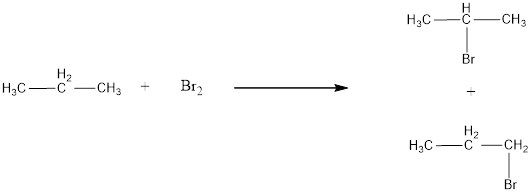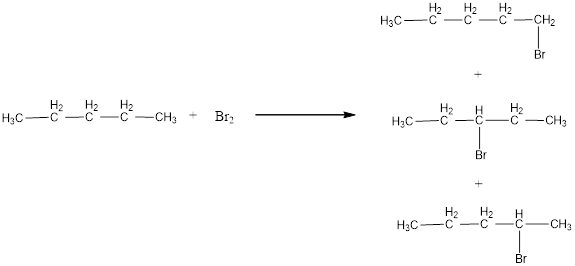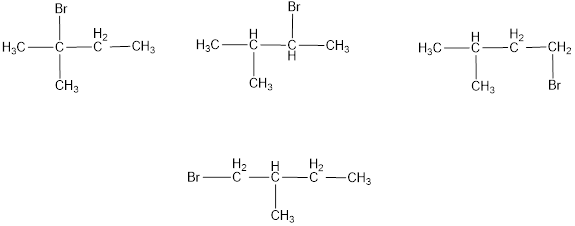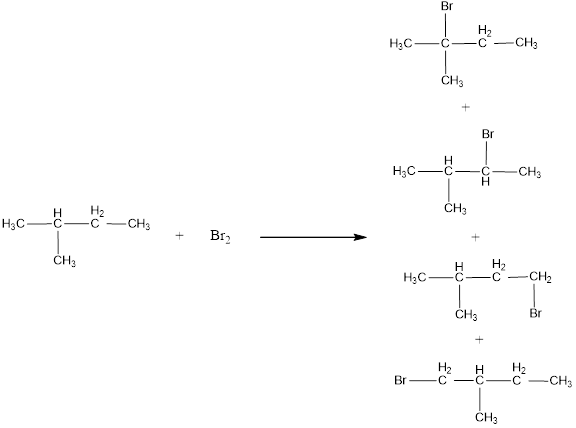
Concept explainers
Write structural formulas for all the possible halogenated hydrocarbon products from the monobromination of the following
- a. Propane
- b. Pentane
- c. 2-Methylbutane
- d. Cyclohexane
(a)
Interpretation:
Structural formula for all the possible monobrominated products obtained from halogenation of propane has to be written.
Concept Introduction:
Alkanes are linear chain saturated hydrocarbons. The reactivity of alkanes are very less. They can be heated for a very long time in strong acids and bases without any reaction. Even strong reducing and strong oxidizing agents have less effect on alkanes.
Alkanes are not completely inert. Two important reactions that alkanes undergo are combustion and halogenation.
Combustion reaction is the one where reaction occurs between substance and oxygen which proceeds with evolution of light and heat. Due to the heat produced when alkanes are made to undergo combustion with oxygen, it is used as fuel.
Halogenation is a chemical reaction between a substance and halogen. The product of halogenation reaction is that one or more halogens are incorporated into molecules of the substance. Halogenation of hydrocarbon gives hydrocarbon derivatives as product where halogen atoms are substituted instead of hydrogen atoms.
Halogenation reaction of alkane is an example of substitution reaction. This is a reaction where a part of reacting molecule replaces an atom or group of atoms in hydrocarbon or hydrocarbon derivative.
Cycloalkanes are also similar to those of alkanes. Cycloalkanes also undergo combustion and halogenation reaction.
Answer to Problem 12.134EP
The monobrominated products of propane are,

Explanation of Solution
Halogenation is a chemical reaction between a substance and halogen. The product of halogenation reaction is that one or more halogens are incorporated into molecules of the substance. Halogenation of hydrocarbon gives hydrocarbon derivatives as product where halogen atoms are substituted instead of hydrogen atoms.
Halogenation reaction of alkane is an example of substitution reaction. This is a reaction where a part of reacting molecule replaces an atom or group of atoms in hydrocarbon or hydrocarbon derivative.
General reaction for halogenation of alkane can be given as shown below,
The halogenation reaction takes place giving a mixture of products where the hydrogen atoms present in the alkane are substituted randomly.
Given alkane is propane. Two kinds of hydrogen is present in propane. Therefore, bromination of propane will lead to two monobrominated product as shown below,

The structural formula for monobrominated product of propane was drawn.
(b)
Interpretation:
Structural formula for all the possible monobrominated products obtained from halogenation of pentane has to be written.
Concept Introduction:
Alkanes are linear chain saturated hydrocarbons. The reactivity of alkanes are very less. They can be heated for a very long time in strong acids and bases without any reaction. Even strong reducing and strong oxidizing agents have less effect on alkanes.
Alkanes are not completely inert. Two important reactions that alkanes undergo are combustion and halogenation.
Combustion reaction is the one where reaction occurs between substance and oxygen which proceeds with evolution of light and heat. Due to the heat produced when alkanes are made to undergo combustion with oxygen, it is used as fuel.
Halogenation is a chemical reaction between a substance and halogen. The product of halogenation reaction is that one or more halogens are incorporated into molecules of the substance. Halogenation of hydrocarbon gives hydrocarbon derivatives as product where halogen atoms are substituted instead of hydrogen atoms.
Halogenation reaction of alkane is an example of substitution reaction. This is a reaction where a part of reacting molecule replaces an atom or group of atoms in hydrocarbon or hydrocarbon derivative.
Cycloalkanes are also similar to those of alkanes. Cycloalkanes also undergo combustion and halogenation reaction.
Answer to Problem 12.134EP
The monobrominated products of pentane are,

Explanation of Solution
Halogenation is a chemical reaction between a substance and halogen. The product of halogenation reaction is that one or more halogens are incorporated into molecules of the substance. Halogenation of hydrocarbon gives hydrocarbon derivatives as product where halogen atoms are substituted instead of hydrogen atoms.
Halogenation reaction of alkane is an example of substitution reaction. This is a reaction where a part of reacting molecule replaces an atom or group of atoms in hydrocarbon or hydrocarbon derivative.
General reaction for halogenation of alkane can be given as shown below,
The halogenation reaction takes place giving a mixture of products where the hydrogen atoms present in the alkane are substituted randomly.
Given alkane is pentane. Three kinds of hydrogen atoms are present in pentane. Therefore, bromination of pentane will lead to three monobrominated product as shown below,

The structural formula for monobrominated products of pentane was drawn.
(c)
Interpretation:
Structural formula for all the possible monobrominated products obtained from halogenation of 2-methylbutane has to be written.
Concept Introduction:
Alkanes are linear chain saturated hydrocarbons. The reactivity of alkanes are very less. They can be heated for a very long time in strong acids and bases without any reaction. Even strong reducing and strong oxidizing agents have less effect on alkanes.
Alkanes are not completely inert. Two important reactions that alkanes undergo are combustion and halogenation.
Combustion reaction is the one where reaction occurs between substance and oxygen which proceeds with evolution of light and heat. Due to the heat produced when alkanes are made to undergo combustion with oxygen, it is used as fuel.
Halogenation is a chemical reaction between a substance and halogen. The product of halogenation reaction is that one or more halogens are incorporated into molecules of the substance. Halogenation of hydrocarbon gives hydrocarbon derivatives as product where halogen atoms are substituted instead of hydrogen atoms.
Halogenation reaction of alkane is an example of substitution reaction. This is a reaction where a part of reacting molecule replaces an atom or group of atoms in hydrocarbon or hydrocarbon derivative.
Cycloalkanes are also similar to those of alkanes. Cycloalkanes also undergo combustion and halogenation reaction.
Answer to Problem 12.134EP
The monobrominated products of 2-methylbutane are,

Explanation of Solution
Halogenation is a chemical reaction between a substance and halogen. The product of halogenation reaction is that one or more halogens are incorporated into molecules of the substance. Halogenation of hydrocarbon gives hydrocarbon derivatives as product where halogen atoms are substituted instead of hydrogen atoms.
Halogenation reaction of alkane is an example of substitution reaction. This is a reaction where a part of reacting molecule replaces an atom or group of atoms in hydrocarbon or hydrocarbon derivative.
General reaction for halogenation of alkane can be given as shown below,
The halogenation reaction takes place giving a mixture of products where the hydrogen atoms present in the alkane are substituted randomly.
Given alkane is 2-methylbutane. Four kinds of hydrogen atoms are present in 2-methylbutane. Therefore, bromination of 2-methylbutane will lead to four monobrominated product as shown below,

The structural formula for monobrominated products of 2-methylbutane was drawn.
(d)
Interpretation:
Structural formula for all the possible monobrominated products obtained from halogenation of cyclohexane has to be written.
Concept Introduction:
Alkanes are linear chain saturated hydrocarbons. The reactivity of alkanes are very less. They can be heated for a very long time in strong acids and bases without any reaction. Even strong reducing and strong oxidizing agents have less effect on alkanes.
Alkanes are not completely inert. Two important reactions that alkanes undergo are combustion and halogenation.
Combustion reaction is the one where reaction occurs between substance and oxygen which proceeds with evolution of light and heat. Due to the heat produced when alkanes are made to undergo combustion with oxygen, it is used as fuel.
Halogenation is a chemical reaction between a substance and halogen. The product of halogenation reaction is that one or more halogens are incorporated into molecules of the substance. Halogenation of hydrocarbon gives hydrocarbon derivatives as product where halogen atoms are substituted instead of hydrogen atoms.
Halogenation reaction of alkane is an example of substitution reaction. This is a reaction where a part of reacting molecule replaces an atom or group of atoms in hydrocarbon or hydrocarbon derivative.
Cycloalkanes are also similar to those of alkanes. Cycloalkanes also undergo combustion and halogenation reaction.
Answer to Problem 12.134EP
The monobrominated products of cyclohexane is,

Explanation of Solution
Halogenation is a chemical reaction between a substance and halogen. The product of halogenation reaction is that one or more halogens are incorporated into molecules of the substance. Halogenation of hydrocarbon gives hydrocarbon derivatives as product where halogen atoms are substituted instead of hydrogen atoms.
Halogenation reaction of alkane is an example of substitution reaction. This is a reaction where a part of reacting molecule replaces an atom or group of atoms in hydrocarbon or hydrocarbon derivative.
General reaction for halogenation of alkane can be given as shown below,
The halogenation reaction takes place giving a mixture of products where the hydrogen atoms present in the alkane are substituted randomly.
Given cycloalkane is cyclohexane. Only one kind of hydrogen is present in cyclohexane. Therefore, bromination of cyclohexane will lead to the same monobrominated product as shown below,

The structural formula for monobrominated product of cyclohexane was drawn.
Want to see more full solutions like this?
Chapter 12 Solutions
General, Organic, And Biological Chemistry, Hybrid (with Owlv2 Quick Prep For General Chemistry Printed Access Card)
- How to solve these types of problems step by step? I'm so confused.arrow_forwardIdentify the expected product of the following Claisen rearrangement. || = IV OV 00000 5 ОН Он Он Он Он || III IV Varrow_forwardCan you please color-code and explain how to solve this and any molecular orbital diagram given? I'm so confused; could you provide baby steps regardless of which problem type they gave me?arrow_forward
- Consider the following structure. OH Esmolol The synthesis of this compound uses a building block derived from either ethylene oxide or epichlorohydrin. 1) Determine which building block was used: | 2) Draw the structure of the nucleophiles that were used along with this building block in the synthesis of the molecule. • Draw one structure per sketcher. Add additional sketchers using the drop-down menu in the bottom right corner. You do not have to consider stereochemistry. Θε {n [arrow_forward< 10:44 5GW 10 Question 7/8 Show Answer Convert 46.0 mm to inches (1 inch = 2.54 cm) 46.0 DAM STARTING AMOUNT 1 cm 1 in 46.0 mm x ☑ 10 mm 10 cm ADD FACTOR DELETE x() X × = 1.81 in = 1 10 Dam ANSWER RESET ១ 2.54 0.0460 mm 10 1000 in 0.001 11.7 m 4.60 18.1 cm 100 1.81 0.394 1 0.1 46.0 0.01 Tap here for additional resourcesarrow_forward< 10:44 Question 6/8 5GW (10 Submit A cake recipe calls for 230.0 mL of buttermilk. How 230.0 many cups is this? DAL STARTING AMOUNT × 1 cups 230.0 mL x = 0.9722 cups 230.0 mL ADD FACTOR DELETE (( ) = 1 cups 230.0 DAE ANSWER RESET ១ 9.722 × 105 0.8706 cups 8.706 × 104 1 L 8.706 × 105 0.9722 quart 10 100 mL 0.001 0.1 6.076 × 103 0.01 9.722 × 104 230.0 0.06076 4 1.0567 1000 6.076 × 104 Tap here for additional resourcesarrow_forward
- < 10:44 Question 6/8 5GW (10 Submit A cake recipe calls for 230.0 mL of buttermilk. How 230.0 many cups is this? DAL STARTING AMOUNT × 1 cups 230.0 mL x = 0.9722 cups 230.0 mL ADD FACTOR DELETE (( ) = 1 cups 230.0 DAE ANSWER RESET ១ 9.722 × 105 0.8706 cups 8.706 × 104 1 L 8.706 × 105 0.9722 quart 10 100 mL 0.001 0.1 6.076 × 103 0.01 9.722 × 104 230.0 0.06076 4 1.0567 1000 6.076 × 104 Tap here for additional resourcesarrow_forwardShow work in detailed of all the options. Don't give Ai generated solutionarrow_forwardPredict the Product. Predict the major organic product for the following reaction:arrow_forward
- Please provide the complete mechanism for the reaction below including arrows, intermediates, and formal charges.arrow_forwardCan you please explain this to me? Maybe color-code it in essence and highlight it.arrow_forwardCan you please color-code and explain this problem to me and is it because its spdf, and then it follows by higher numver so 3 first and so forth ...arrow_forward
 Organic And Biological ChemistryChemistryISBN:9781305081079Author:STOKER, H. Stephen (howard Stephen)Publisher:Cengage Learning,
Organic And Biological ChemistryChemistryISBN:9781305081079Author:STOKER, H. Stephen (howard Stephen)Publisher:Cengage Learning, General, Organic, and Biological ChemistryChemistryISBN:9781285853918Author:H. Stephen StokerPublisher:Cengage Learning
General, Organic, and Biological ChemistryChemistryISBN:9781285853918Author:H. Stephen StokerPublisher:Cengage Learning World of Chemistry, 3rd editionChemistryISBN:9781133109655Author:Steven S. Zumdahl, Susan L. Zumdahl, Donald J. DeCostePublisher:Brooks / Cole / Cengage Learning
World of Chemistry, 3rd editionChemistryISBN:9781133109655Author:Steven S. Zumdahl, Susan L. Zumdahl, Donald J. DeCostePublisher:Brooks / Cole / Cengage Learning- Chemistry: Matter and ChangeChemistryISBN:9780078746376Author:Dinah Zike, Laurel Dingrando, Nicholas Hainen, Cheryl WistromPublisher:Glencoe/McGraw-Hill School Pub Co
 Chemistry: Principles and PracticeChemistryISBN:9780534420123Author:Daniel L. Reger, Scott R. Goode, David W. Ball, Edward MercerPublisher:Cengage Learning
Chemistry: Principles and PracticeChemistryISBN:9780534420123Author:Daniel L. Reger, Scott R. Goode, David W. Ball, Edward MercerPublisher:Cengage Learning Chemistry: The Molecular ScienceChemistryISBN:9781285199047Author:John W. Moore, Conrad L. StanitskiPublisher:Cengage Learning
Chemistry: The Molecular ScienceChemistryISBN:9781285199047Author:John W. Moore, Conrad L. StanitskiPublisher:Cengage Learning





